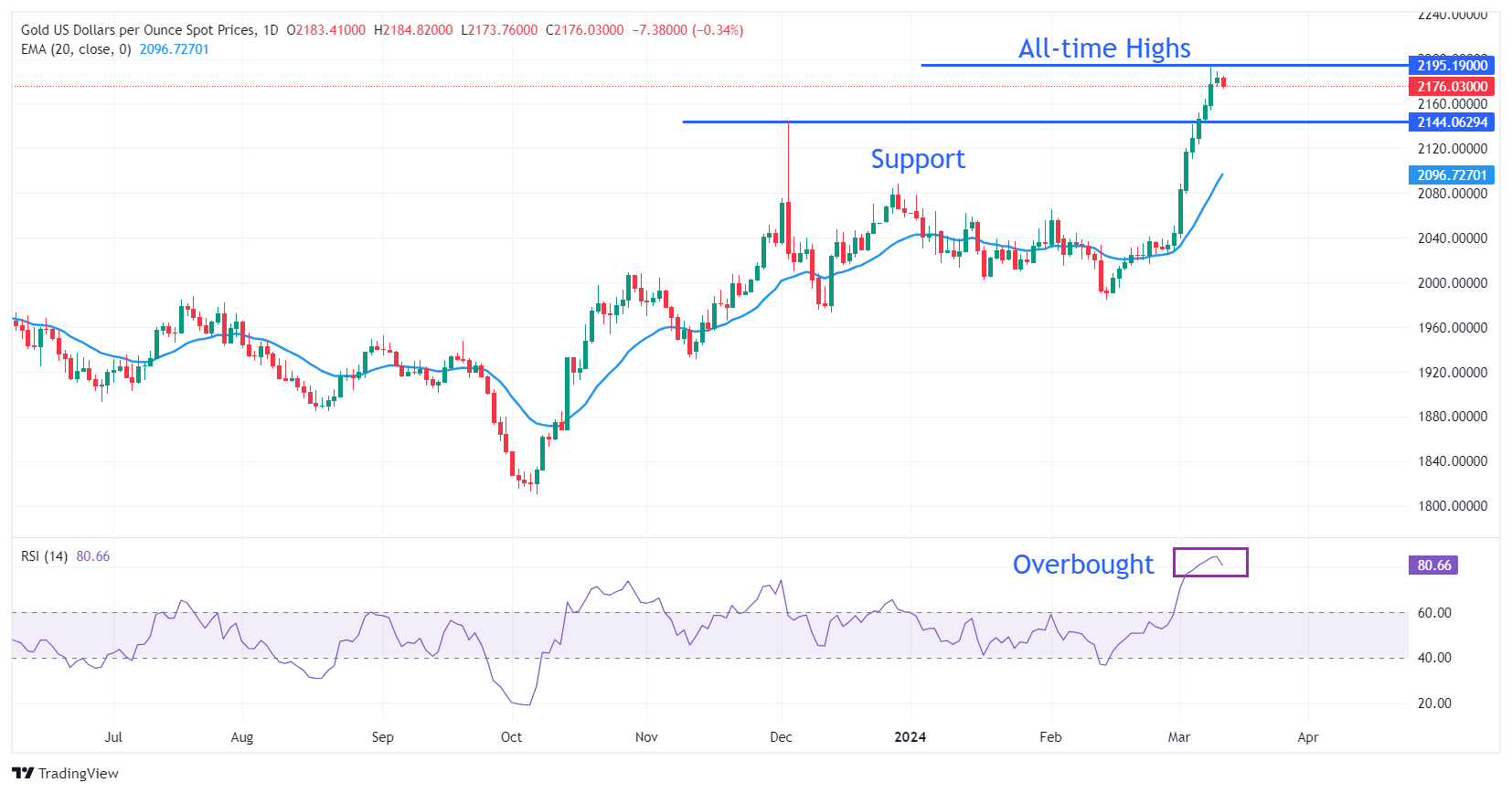Gold plummets as stubborn US Inflation dents Fed rate cut expectations for June

- Gold price tumbles as the US inflation turns out sticky.
- Market expectations for the Fed reducing interest rates in June could be impacted.
- US annual headline inflation accelerated to 3.2%, and core CPI grew by 3.8%.
Gold price (XAU/USD) faces intense selling pressure as the United States Bureau of Labor Statistics (BLS) has reported stubborn Consumer Price Index (CPI) data for February in Tuesday’s early New York session. Strong CPI data lead to declining market expectations for Federal Reserve (Fed) rate cuts in the June policy meeting. Stubborn price pressures have increased of opportunity cost of holding investments in non-yielding assets, such as Gold.
The hotter-than-expected inflation report leads to an increase in yields on interest-bearing bonds. 10-year US Treasury yields rebounded strongly to 4.15%. The US Dollar Index (DXY), which closely tracks the Greenback’s value against six major currencies, climbs to 103.20.
The USD index broke Monday’s trading range on the upside as sticky inflation data is expected to allow Fed policymakers to avoid rushing for interest rate cuts. In the broader term, a sticky inflation report will also improve the appeal of the US Dollar, as it would allow the Fed to keep interest rates higher for a longer period.
Daily digest market movers: Gold price weakens after sticky US Inflation data
- Gold price tumbles as the United States consumer price inflation data remains stubborn than expectations
- Monthly headline CPI rose by 0.4%, as expected, against a 0.3% increase in January. The monthly core CPI, which excludes volatile food and energy prices, grew at a steady pace of 0.4% while investors anticipated it to rise by 0.2%. Annual headline inflation was up by 3.2% against expectations and the prior reading of 3.1%. The core CPI accelerated at 3.8% from expectations of 3.7% but lower than the former reading of 3.9%.
- Hotter-than-expected inflation data would allow Federal Reserve policymakers to avoid rushing for rate cuts. Fed policymakers may reiterate that a victory over inflation is not in sight. Also, the uncertainty over the interest rate cuts in the first half of this year will deepen as policymakers could lean towards keeping interest rates higher.
- Last week, Fed Chair Jerome Powell said in his Congressional testimony that it would be inappropriate to start lowering interest rates before gaining conviction that inflation will sustainably return to the 2% target. However, Powell also said that the central bank is not far from gaining that conviction.
- Before the release of the US CPI data, market expectations for the Fed reducing interest rates in the June meeting were firm as labor market conditions are not overly tight. The US Nonfarm Payrolls (NFP) report for February showed slower wage growth and a higher Unemployment Rate, though hiring remains robust. The CME FedWatch tool shows that there is a 72% chance that the Fed will cut interest rates in June.
Technical Analysis: Gold price falls to $2,160
Gold price breaks below the three-day tight range, between $2,170 and all-time highs of $2,195, after sticky US inflation data. The nine-day winning streak of the Gold price halts amid uncertainty over Fed rate cut expectations. The divergence between the 20-day Exponential Moving Average (EMA) at $2,097 and the Gold price is waning. The asset tends to face a mean-reversion move after a wide divergence, which results in a price or a time correction.
On the downside, December 4 high near $2,145 and December 28 high at $2,088 will act as major support levels.
The 14-period Relative Strength Index (RSI) reaches the overbought territory at 84.50, pointing to some correction ahead.
Fed FAQs
Monetary policy in the US is shaped by the Federal Reserve (Fed). The Fed has two mandates: to achieve price stability and foster full employment. Its primary tool to achieve these goals is by adjusting interest rates. When prices are rising too quickly and inflation is above the Fed’s 2% target, it raises interest rates, increasing borrowing costs throughout the economy. This results in a stronger US Dollar (USD) as it makes the US a more attractive place for international investors to park their money. When inflation falls below 2% or the Unemployment Rate is too high, the Fed may lower interest rates to encourage borrowing, which weighs on the Greenback.
The Federal Reserve (Fed) holds eight policy meetings a year, where the Federal Open Market Committee (FOMC) assesses economic conditions and makes monetary policy decisions. The FOMC is attended by twelve Fed officials – the seven members of the Board of Governors, the president of the Federal Reserve Bank of New York, and four of the remaining eleven regional Reserve Bank presidents, who serve one-year terms on a rotating basis.
In extreme situations, the Federal Reserve may resort to a policy named Quantitative Easing (QE). QE is the process by which the Fed substantially increases the flow of credit in a stuck financial system. It is a non-standard policy measure used during crises or when inflation is extremely low. It was the Fed’s weapon of choice during the Great Financial Crisis in 2008. It involves the Fed printing more Dollars and using them to buy high grade bonds from financial institutions. QE usually weakens the US Dollar.
Quantitative tightening (QT) is the reverse process of QE, whereby the Federal Reserve stops buying bonds from financial institutions and does not reinvest the principal from the bonds it holds maturing, to purchase new bonds. It is usually positive for the value of the US Dollar.
